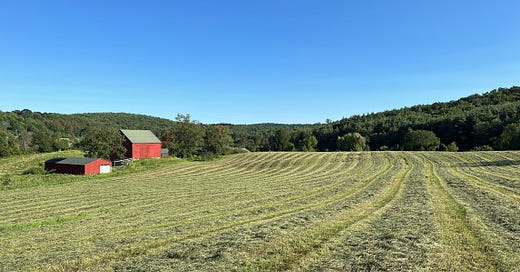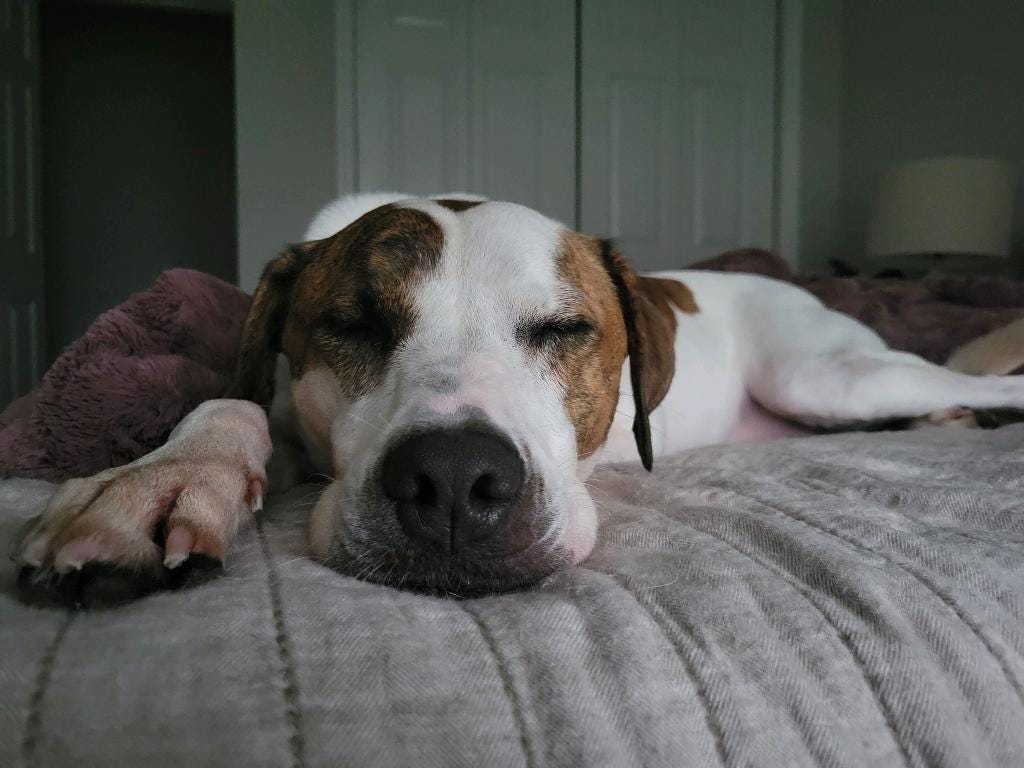Last year the summer months were so terribly bone dry it was a tough haying season. This summer it was so terribly wet it has been a tough haying season.
Our first cutting was really late in the game due to rain—our farmer, John, has dozens of fields he leases and maintains nearby so he has enough summer grazing fields and hay for the winter months for his farm, when he takes all the cattle back to his farm for winter and then needs the hay to feed them until they’re back on pasture in the Spring.
Our farm got mowed late in the rotation this summer, which is absolutely fine—as long as it gets done in a reasonable window it doesn’t matter if it’s a little early or a little late, though the quality of hay isn’t so hot this year either because of how much its rained.
When it comes to second cutting there’s a lot of luck and timing involved. As the overnight temperatures dip down into the 40s and the daytime temps hover in the 70s, there comes a point in the haying season where second cutting gets tricky, and then at some point isn’t possible. When the field is mowed, the grass rests so that it can dry out and then be raked into windrows, which are then baled into hay.
Have you ever heard of a hay fire? Ever heard about how hay bales can spontaneously combust? Many of you know the story about how the original late-1700s farmhouse that was here on this farm burned down in a hay fire in the summer of 2004.
Some wet hay was baled and stored in the barn and on a hot windy day it caught fire and took the barn, corn crib, woodshed, and the whole house with it. Thankfully no one was hurt, but hay fires are sadly common and so there’s both an art and a science to cutting and storing hay.
In our case, we need it as dry as possible to be able to stack and store inside a closed barn. Some farmers bale their hay and leave it out in the fields, which is ok for a period of time but the bales do begin to break down. You may have also seen hay bales out in fields wrapped in white plastic…those are what is called haylage, as the hay is baled up with some moisture content in it and then ferments inside the wrapping. Have you ever driven by a farm and noticed the huge piles usually with concrete walls built around it and old tires on top? That’s what’s called silage, basically fermented hay that has less moisture content than haylage does, but it’s the same concept. So…if you didn’t know, now you know! We learned all these things from our neighbors when we moved here and had a million questions about farming!
Back to second cutting—once September hits and the overall temps start getting lower and there’s less daylight, too, it’s a recipe for not having enough time for the hay to dry. It gets wet overnight when the grass dews, and then there’s generally a lot of fog and mist in September mornings which takes a lot longer to burn off than in the summertime.
Ideally, you want two or three days in a row where it is planned to be hot and sunny so the field can be cut, the grass dried, and then baled dry to be put away dry.
For John, the tricky part is only having so many hours in the day while working an off-farm job, too, having only so much equipment, and having lots of fields that all need haying. It’s a bit of art and a bit of science and a dance with the weather forecast and a busy family schedule to be able to get it all done.
When John and I checked in last week, the weather was looking really good to get the haying done on our fields but their family shows dairy cows at two of the local county fairs, which takes up a majority of their days on top of managing their farm and another job. So we’d planned for it, weather permitting, to get done sometime this week.
John came by on Thursday morning and got the big hay field cut for the second time and the two big back fields cut for the first time—the big hay field he’ll bale into about 200 square bales for us to use for the donkeys for the winter, and the back fields he’ll bale up into giant round bales to take back down to his farm.
We’ve thankfully had good weather since the field was mowed, and he’ll be by with his brother Charlie who will rake the hay into windrows with a tractor and hay rake attachment and then John will come back around with the baler and a wagon to bale the hay and load it into a wagon. That should happen either today (Sunday) or tomorrow.
Once the hay is baled, that’s when Chris and I tag in—we’ll get it all loaded and stacked into the Big Barn for the winter. Those 200 bales of hay should last us all the way to next second cutting hay season—enough hay for the donkeys for a year.
Chris happens to be in Florida at the moment visiting a group of his high school friends. He headed down on Thursday morning to watch a UCF football game and then off to spend a few days catching up with old friends.
If the hay got baled today then yours truly would have a long, hard workout ahead of her to get the hay loaded into the barn! But it’s looking like it’ll more than likely be Monday and then I’ll have my teammate back home for us to be able to knock it out together.
Even if Chris hadn’t been back yet, my sister Jaclyn was scheduled to be in town this weekend. She was to arrive on Saturday and head back to Alabama on Tuesday evening but she called me in tears on Friday night after the boarding facility where she boards her dog, Ari, called and said she was mercilessly scratching the door and chewing and scratching up her teeth and paws and drooling all over herself and making herself nutty with worry.
Jackie rescued Ari, who was found as a stray, several years ago after she and I came home from our deployment together to the UAE. Jackie was there for a year and I was there with her for six months…coolest Air Force experience we’ve both had together to date. So when Jackie came back to the states she was ready to start looking for a dog and as she was in the process of adopting a different dog, there was Ari.
She’s done such a phenomenal job with her through the years—Ari can have really bad anxiety with noise, stimulation, children, and storms and Jackie’s done everything imaginable to work with her through her worried mind. She’s done ok in boarding before and Jackie has preferred that over other options because she gets to be in doggie daycare all day with other dogs, too, like she is during the week when Jackie works. This boarding facility (that she’d been to before) said they’d give her some medication to help calm her down but you all know me (and Chris, too)…that wasn’t going to sit well with me for Jackie to be here while she and I both worried about Ari in boarding. So we both agreed for her to cancel her trip and she’s now in the process of looking for an in-home sitter, which hopefully is ultimately better all around.
So if the hay didn’t get done this week it would have hopefully been done the next, and if Chris wasn’t here it would have been Jackie helping me load hay, and since Jackie couldn’t come it was about to be me loading hay today on my own (which may still happen, we’ll see!). BUT! Thankfully we’ve always got a plan, and then a plan B, and it’s looking like this week’s farm dance with Mother Nature and busy schedules and lots of balls in the air and all the changes has worked out somehow…just as it always does.







Sarah.........always a joy reading your farm notes..in time I will most likely pledge a subscription......Keep up the great work. much appreciated from an ole gal of 72.